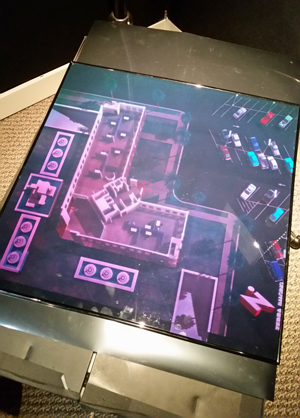
Fifteen years into the 21st century, construction-related technology has yet to produce jetpacks, ironworker robots and other items predicted by science fiction. But one futuristic product is already available—three-dimensional holographic prints that provide unique visualizations of project designs and concepts for collaboration.
The technology, developed by Zebra Imaging Inc., Austin, Texas, encodes 3D digital data from a variety of software products onto specially designed polymer film tiles ranging in size from 12 in. by 12 in. to 24 in. by 34 in. using a proprietary imaging process. The tiles are patterned with 0.7-mm hogels—3D picture elements comparable to pixels—that can store vast amounts of data.
Illuminated by a halogen or LED light source, the print produces a precisely detailed holograph that is viewable from all angles without the need for special glasses or other equipment often associated with 3D technologies.
Originally developed in the late 1990s, Zebra Imaging’s holographic process has evolved in step with 3D software and storage technology and real-world applications such as those supporting U.S. military operations in the Middle East.
According to Zebra CEO Chuck Scullion, the larger files have more storage capacity than a high-definition DVD. “That produces holographs with a tremendous degree of accuracy, and in a format that is easy to display and store,” Scullion says.
He adds that the prints have been used to display designs for individual building and mixed-use projects, stadiums, bridges and transit systems, as well as existing conditions of buildings and infrastructure used for pre-project planning.
In addition, up to four multiview overlays, or “channels,” can also be incorporated into each print to display iterative phases, specific segments or structural and MEP systems.
Zebra Imaging’s holographic prints can be used for project team discussions, bid presentations, stakeholder group meetings and public engagement activities. Scullion cites tests that correlate the use of holographic images with higher information retention, making the prints a valuable aid in sharing complex information with nontechnical audiences.
“Everyone can see and understand the holograph, which isn’t always the case with other 3D technologies,” he says. He adds that unlike physical models, the holographic prints are easier to transport and store flat. Multiple copies of the prints allow the same holographic images to be shared among multiple groups or used as leave-behinds.
The holographic prints can be created from a variety of high-resolution data sources, including CAD/CAE/CAM files, aerial photos and Lidar scans, as well as commonly used 3D data programs. A recent plug-in developed for Autodesk’s Revit allows that program’s .fbx BIM files to be directly converted into .obj files for creating holographs, bypassing what was once a multistep procedure.
After uploading the base files to Zebra Imaging for processing, customers typically receive the completed prints within seven to 10 days. Scullion explains that though the actual processing time per print is only two to three hours,
Zebra Imaging’s graphics support team first analyzes the files to ensure proper layout and print quality.
Depending on the size of the print, a monochrome hologram can cost from $149 to $879, while a color version can cost up to $1,999. Multiview overlays are an additional 10% per channel.




Post a comment to this article
Report Abusive Comment